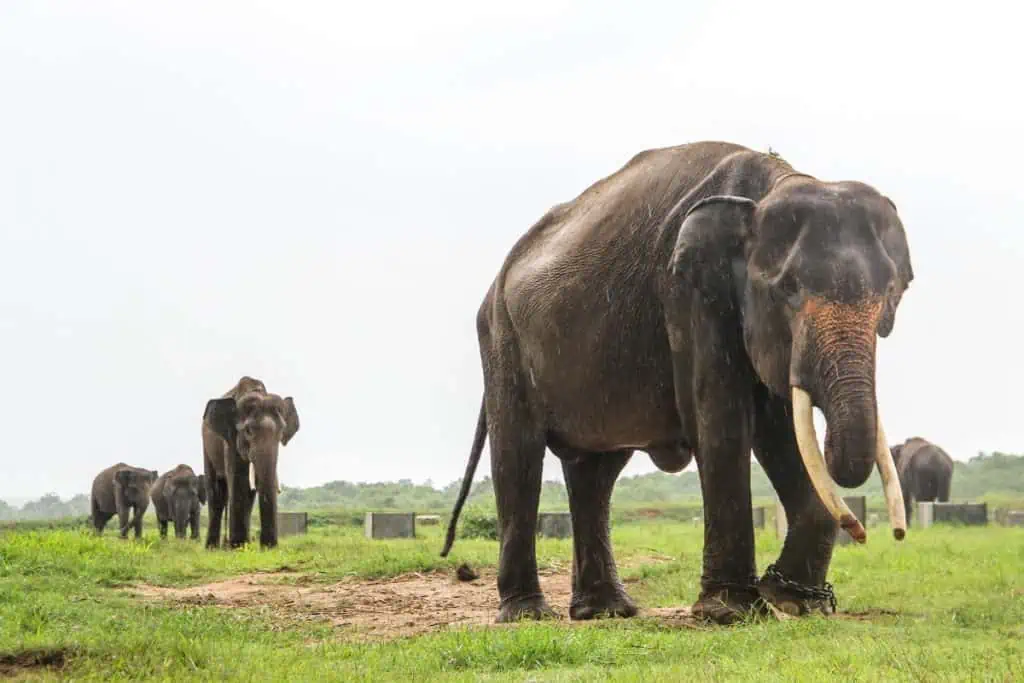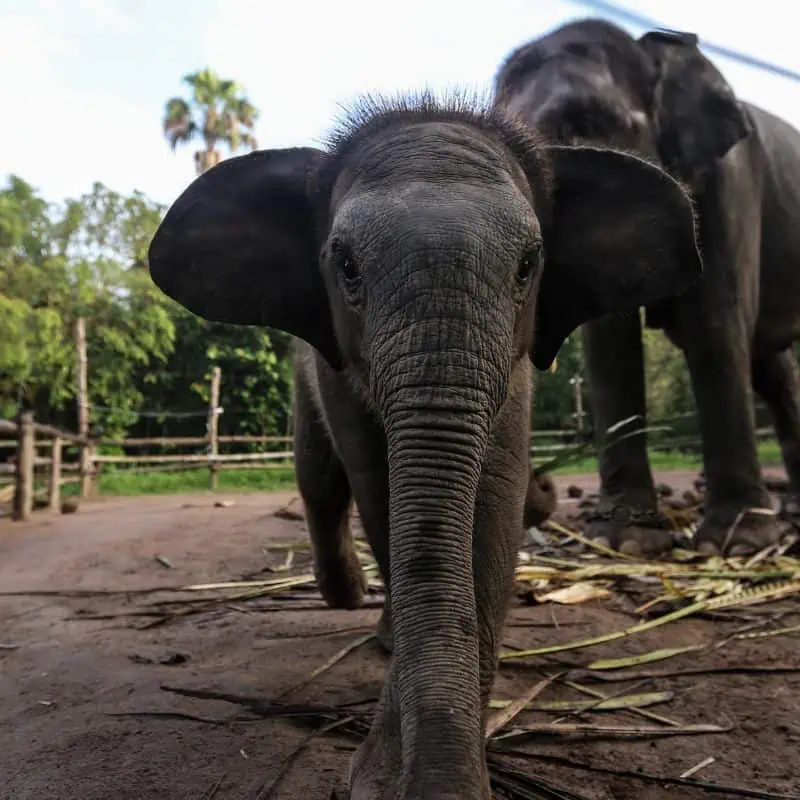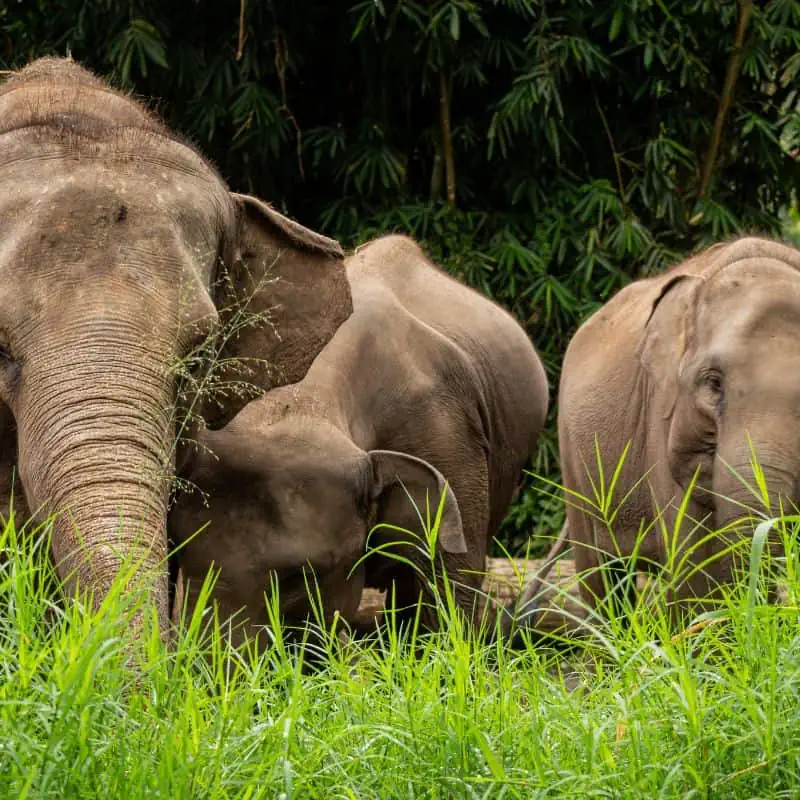On the Island of Sumatra, humans and elephants have coexisted peacefully, but not always. Sumatran elephants play an essential role in keeping the ecosystem healthy. Yet, recently these elephant species have been facing threats of being endangered.
Sumatran elephants are known by the scientific name Elephas Maximus Sumatranus and are one of the three Asian elephant subspecies. These elephants are native to Sumatra’s Island, Indonesia. Being the smallest Asian elephant species, they grow around 20 feet long and are between 5 to 9 feet tall. These elephants can weigh approximately 5 tonnes.
Sumatran elephants are very social and intelligent. They need a lot of land and thrive in lowland environments.

- 1. They Are Scientifically Called Elephas Maximus Sumatranus
- 2. Sumatran Elephants Are a Small Subspecies
- 3. Male and Female Sumatran Elephants Have Tusks
- 4. Sumatran Elephant’s Trunk Is a Prominent Feature
- 5. They Live on Sumatra Island, Indonesia
- 6. Sumatran Elephants Are Very Social Animals And Stay In Herds
- 7. These Elephants Are Active During the Day
- 8. Sumatran Elephants Breed Throughout The Year
- 9. Their Population Is 2,400 to 2,800
- 10. Sumatran Elephants Are Critically Endangered
- Final Thoughts on Sumatran Elephants
- FAQS
1. They Are Scientifically Called Elephas Maximus Sumatranus
The scientific name for this elephant is Elephas Maximus Sumatranus. “Elephas” is the Greek word for “tusks or ivory.”
The Latin word “Maximus” means “the greatest.” “Sumatranus” comes from the place where these elephants live, Sumatra.
Sumatran elephants belong to the Elephantidae family and class Mammalia.
2. Sumatran Elephants Are a Small Subspecies
Sumatran elephants are among the smaller Asian species with significant genetic, morphological, and anatomical differences.
They have bright-colored skin with few depigmented spots and are nearly bald and gray.
Sumatran elephants grow to around 20 feet long and are 5 to 9 feet tall. On average, these elephants weigh approx. 5 tonnes.
Unlike African elephants, Sumatran elephants have a rounded shape, small ears, and long trunks.

3. Male and Female Sumatran Elephants Have Tusks
Sumatran elephants, both male, and female, have tusks. Males have a very visible tusk, but they aren’t very long.
Female Sumatran elephants also have tusks but are generally very short and often hidden under their upper lip. Sometimes, female elephants may not even have tusks.
4. Sumatran Elephant’s Trunk Is a Prominent Feature
These giant mammals use their trunks for any purpose and in various ways. Elephants use their trunks to take up water to their mouths.
It’s also used to grab things, breathe, smell, shower, and trumpet for communication.
The incredible thing about the Sumatran elephant trunk is that it’s made up of more than 40,000 muscles.

5. They Live on Sumatra Island, Indonesia
Sumatran elephants are native to the Island of Sumatra in Indonesia. They prefer living in lowlands, though they may come to hilly and mid-altitude moist forests in certain seasons.
They travel based on their needs, but Sumatran elephants prefer to live in areas below 300m.
To protect them from the harsh weather, Sumatran elephants have thick skin. They are essential in maintaining the health of the ecosystem.
These elephants spread seeds as they defecate, helping the growth of plants.
6. Sumatran Elephants Are Very Social Animals And Stay In Herds
Sumatran elephants are very social mammals. They live in a herd of 20 to 35 or sometimes even as little as 3 – 23 elephants.
The largest and oldest adult female dominates the pack. As they reach their adolescence, males are left on their own. They may only return to the herd for mating.
Female elephants live with the herd and become nannies, caring for the young. In the pack, the bonding is powerful.
To communicate with the rest of the herd, Sumatran elephants use low-frequency sounds. These sounds are usually soft vibrations produced by the upper trunk.

7. These Elephants Are Active During the Day
Sumatran elephants are active throughout the day in most cases.
Yet, it’s noted that their activity increases 2 hours before late noon and goes on till 2 hours before dawn.
That’s when they go searching for food. During their active hours, these elephants always travel in groups to maintain the herd’s integrity.
8. Sumatran Elephants Breed Throughout The Year
There isn’t much information about the mating and reproductive habits of Sumatran elephants, but it’s known that they do breed throughout the year.
Yet, the peak breeding period is in the rainy season.
The gestation period for female Sumatran elephants is around 22 months. A single baby is born every four years. At birth, these elephants weigh about 100 kg or less.
9. Their Population Is 2,400 to 2,800
Today, only 2,400 to 2,800 Sumatran elephants are left worldwide, as specified by WWF. This number is constantly decreasing.
Between 1980 to 2005, 69% of the potential Sumatran elephant habitat had been lost. Sumatra also lost around 50% of its elephants around this time. If this decline continues, Sumatran elephants may be extinct within the next 30 years. The remaining elephants are kept in captivity.
10. Sumatran Elephants Are Critically Endangered
The numbers of these species are still rapidly declining, classifying them into the IUCN Red List of Critically Endangered Species.
That means that this rapid decline can eventually lead to the extinction of these species.
The biggest threat to Sumatran elephants is the human-elephant conflict. As humans turn natural elephant habitats into human settlements, large numbers of Sumatran elephants are disturbed or killed.
Poaching is also a growing concern because agriculturalists kill these elephants for their purpose.
Final Thoughts on Sumatran Elephants
Sumatran elephants are the smallest Asian elephant species living on Sumatra Island. These social animals live on lowlands but move to higher lands occasionally.
Females are the leaders of the herd, while males live solitarily. Sumatran elephants are genuinely incredible creatures.
FAQS
How Long Do Sumatran Elephants Live?
Sumatran Elephants usually live for around 55 to 70 years in the wild. However, these elephants are known to live as long as 75 years in captivity. Once they cross the age of 60, female Sumatran elephants stop reproducing.
What Do Sumatran Elephants Eat?
Sumatran elephants are herbivores and usually feed on fruit, grass, seeds, leaves, and bark. They eat more than 100 vegetation and plant species. Sumatran elephants eat as much as 150 kg of feed and 200 liters of water daily.
Why Are Sumatran Elephants Going Extinct?
Poaching and deforestation are the two main factors leading to the endangerment of Sumatran elephants over time; these species steadily declined and are now critically endangered.

